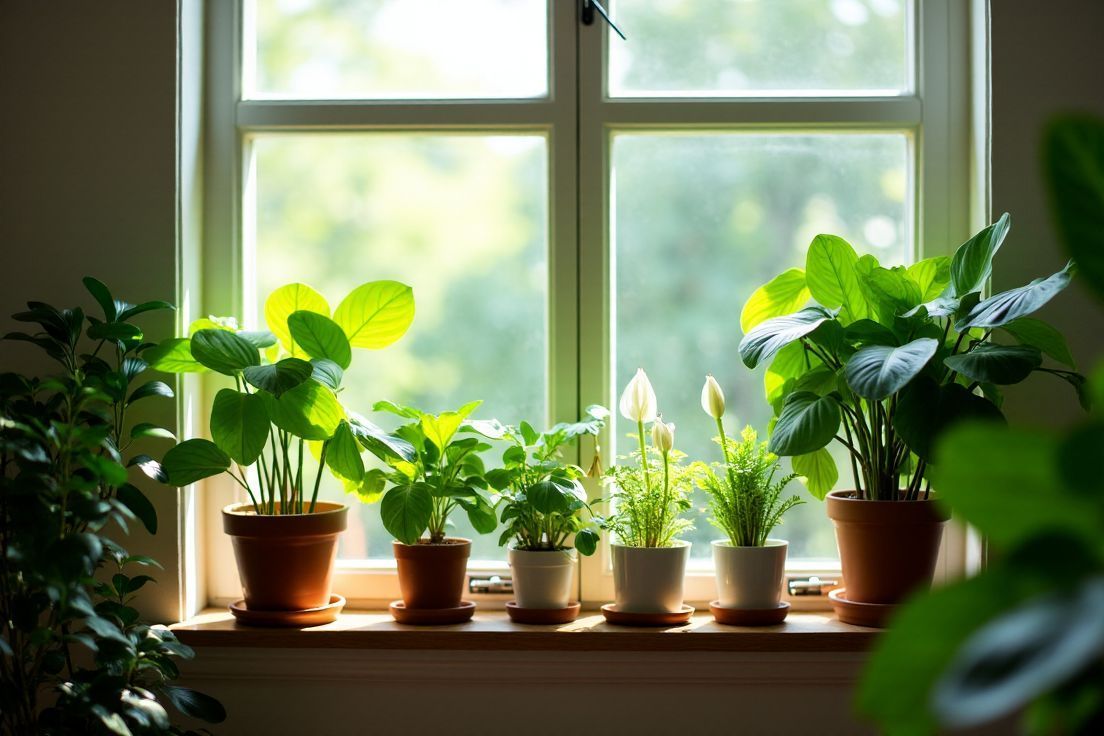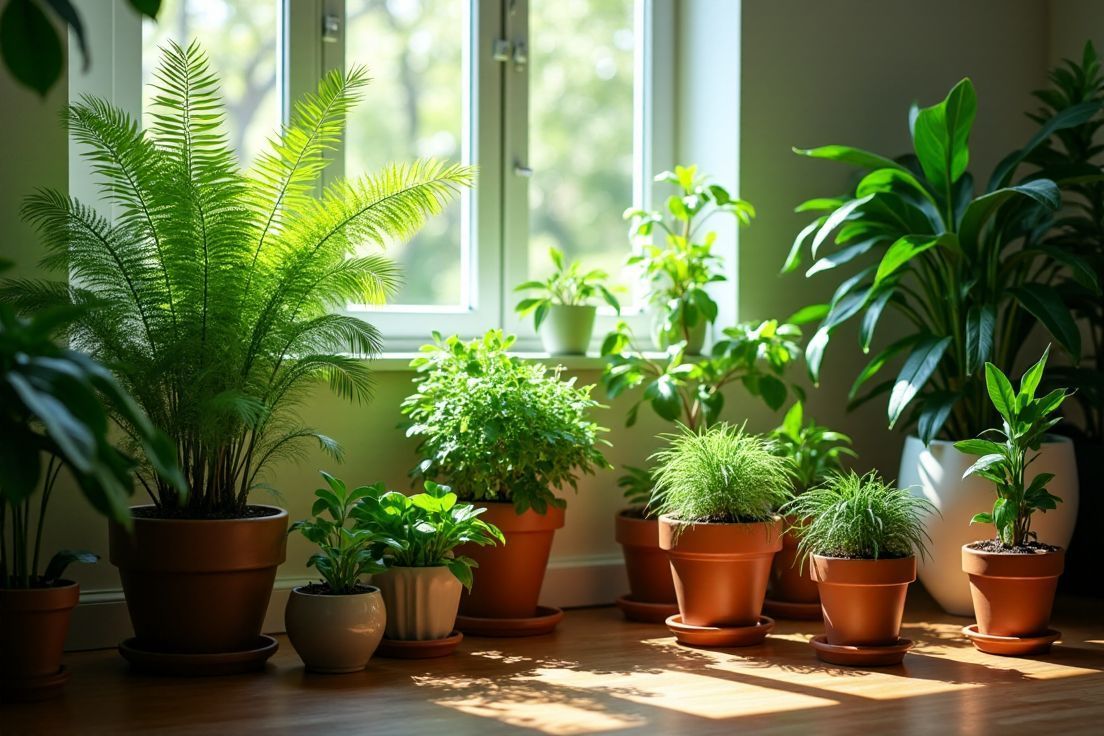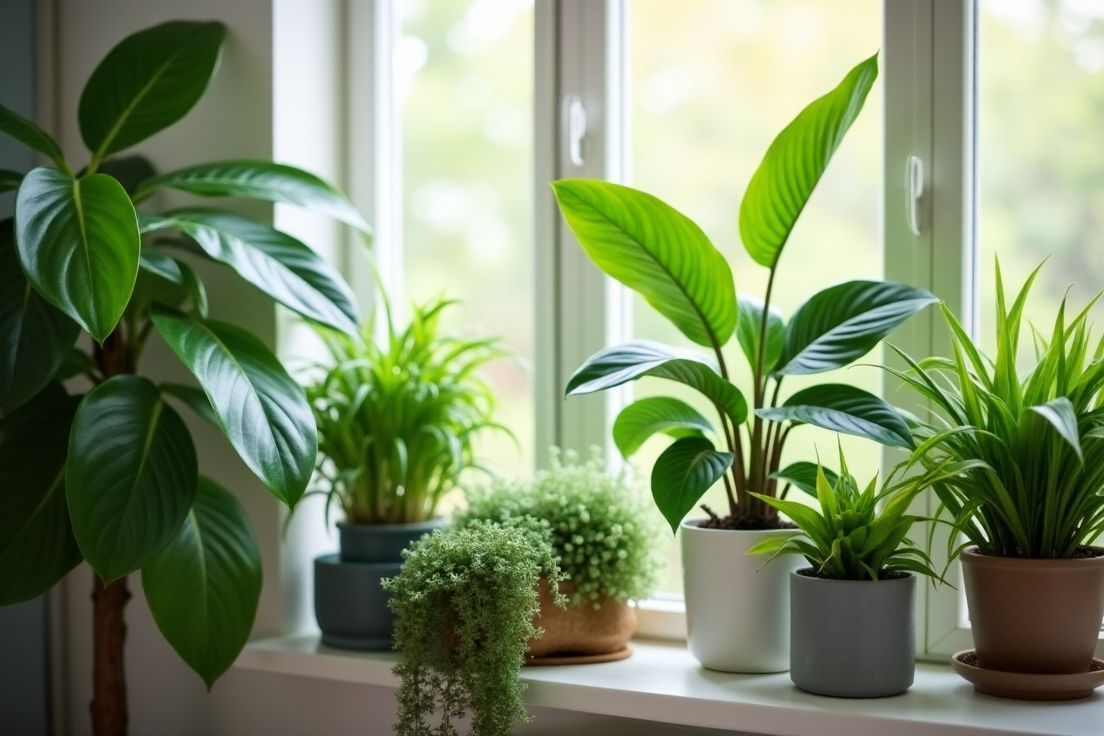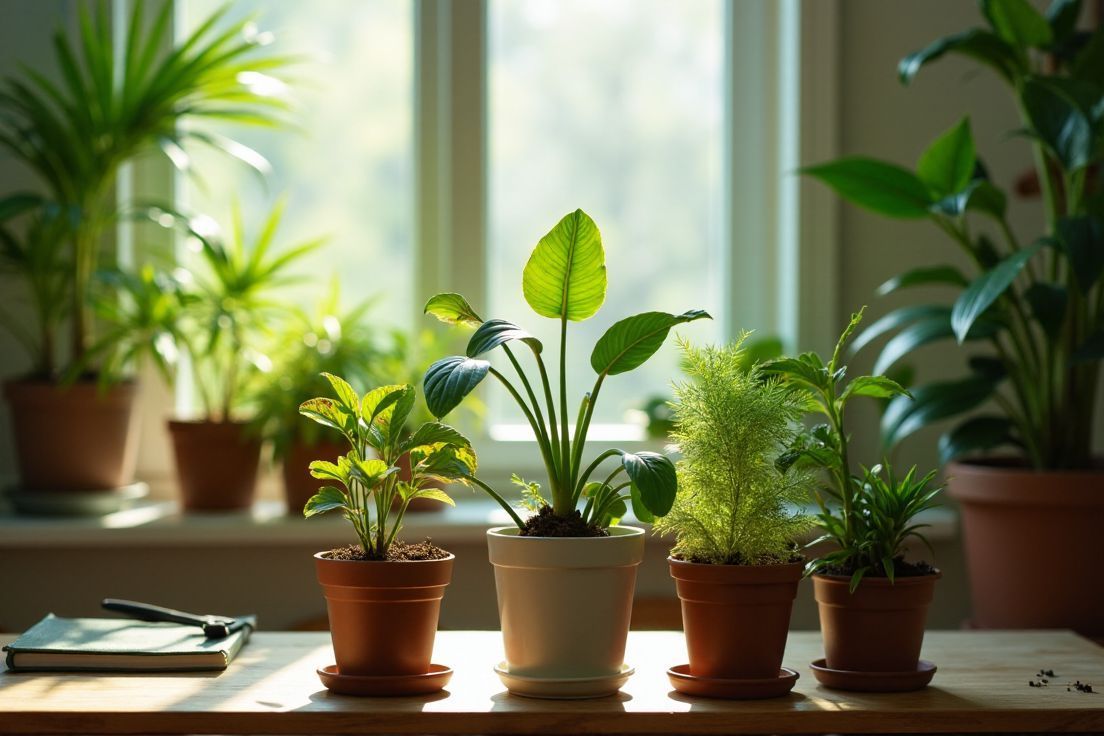
However, choosing the right plants and understanding how to care for them can sometimes feel overwhelming. In this blog post, we’ll explore the ins and outs of selecting the best houseplants for your space and how to keep them healthy.
From understanding light levels to watering needs, we’ll provide you with all the essential tips you need to make your houseplants thrive!
Selecting the Best Houseplants

When choosing houseplants, it’s important to consider how much light your home receives. Bright, indirect light can support a range of plants, such as pothos and spider plants.
If you have a spot that gets direct sunlight, succulents and cacti thrive in those conditions. In dimmer areas, try varieties like snake plants or ZZ plants, which can tolerate lower light.
Another factor to consider is your watering schedule. Some plants, like peace lilies, prefer moist soil, while others, like succulents, need to dry out between waterings.
Make sure to look at the care needs and adjust based on your routine.
Temperature plays a key role as well.
When considering care needs, it’s important to adjust them based on your routine and the temperature requirements. Below is a table that summarizes various factors to consider for optimal care.
| Factor | Importance | Adjustment Recommendations |
|---|---|---|
| Temperature | Critical | Keep within recommended range for comfort. |
| Humidity | Moderate | Adjust moisture levels to avoid dryness or mold. |
| Light Exposure | Important | Ensure adequate light without direct sunlight. |
| Watering Schedule | Essential | Modify based on season and temperature. |
| Nutrient Supply | Beneficial | Fertilize regularly based on growth stage. |
| Pest Control | Necessary | Monitor regularly and treat as needed. |
Most houseplants thrive in warm conditions, ranging from 60F to 75F. Keep plants away from drafts, heaters, or vents that can cause temperature swings.
Humidity is another aspect to think about. Tropical plants love humidity, so you might need to mist them or use a pebble tray to create a more suitable environment.
When caring for tropical plants, humidity plays a crucial role in their health and growth. Here are some tips to help maintain the right humidity levels:
- Consider using a humidifier to continuously maintain ideal humidity levels for your plants.
- Group your tropical plants together; their combined transpiration will increase the local humidity.
- Regularly check the moisture level in the soil; if it’s drying out quickly, your plants may need more humidity.
- Use a humidity meter to monitor the levels in your plant area for better adjustments.
- Place your plants in well-lit bathrooms or kitchens, which often have higher humidity levels than other rooms.
On the other hand, succulents and cacti do fine in dry conditions.
Lastly, consider the size and growth habits of the plants you are interested in.
Some can grow quite large and may need more space, while others remain compact and can fit on a table or shelf. Think about where you want to place your houseplants and choose accordingly.
By considering light, water, temperature, humidity, and size, you can select the best plants that will flourish in your home.
Low Light Options
For those who have areas in their homes with limited light, there are excellent plant choices. Some thrive in darker spaces and still bring life to your home.
One popular option is the snake plant, also known as Sansevieria. This plant is sturdy and can endure low light.
It also tolerates neglect, making it ideal for busy schedules.
The ZZ plant is another great choice.
Its waxy leaves stay vibrant in dimmer environments and require minimal watering. This makes it perfect for beginners.
Consider the pothos plant as well. It has trailing vines and does well in shade.
Its heart-shaped leaves can be found in various colors, adding to its appeal.
Peace lilies not only look great but can also grow in low-light conditions.
They produce lovely white flowers and help to purify the air in your home.
Finally, the philodendron is a versatile option that does well in low light.
Its climbing vines can be trained along a trellis or left to hang in a pot, giving you creative ways to display them.
Choosing the right low light plants can enhance any space, even in areas with little natural sunlight.
Medium Light Choices
Medium light plants are perfect for spots in your home that receive some sunlight but not too much. They can thrive in places like rooms with east or west-facing windows.
Medium light plants are a wonderful addition to your home, especially in areas that enjoy moderate sunlight. Here are some key points to consider:
- Ideal for rooms with indirect sunlight exposure.
- Enhance indoor air quality while adding beauty to your space.
- Typically easier to care for than low-light plants, as they require a bit more light for growth.
- Variety of species available that can suit different decor styles.
- Can adapt to slightly varying light conditions, making them versatile choices.
These plants generally need bright, indirect light or filtered light to reach their full potential.
One great choice is the rubber plant.
With its large, shiny leaves, it adds a touch of elegance to any room. It grows well in medium light and can tolerate some shade.
Another option is the Chinese evergreen. This plant has attractive foliage and is known for being easy to care for.
It’s very forgiving, making it a nice choice for beginners.
Fiddle leaf figs are also popular.
They can grow quite tall and have large, beautiful leaves. They thrive with bright, filtered light but can survive in medium light as well.
Just make sure to rotate the plant occasionally to keep it growing evenly.
The dragon tree adds a unique flair to your collection.
It has long, slender leaves and does well with some light. This plant can adapt to different light conditions and is relatively low maintenance.
Lastly, consider the peace lily for medium light environments. This plant not only looks lovely with its white blooms, but it also helps clean the air.
It can tolerate medium light and prefers to be kept slightly moist.
Overall, there are many options for medium light plants that can liven up your space while being easy to care for.
Bright Light Favorites
Bright Light Favorites
Bright light plants thrive in areas where they receive plenty of sunshine. These plants often grow faster and look healthier in good light conditions.
A few favorites include:
The snake plant, also known as Sansevieria, is a favorite for those bright spots. Its striking leaves grow upright and can tolerate some neglect.
The fiddle leaf fig is another popular choice. With its big, glossy leaves, it becomes a stunning focal point.
It thrives in bright, indirect light but can handle some direct sun.
The monstera, or split-leaf philodendron, is very trendy.
Its unique leaves can grow quite large, adding drama to your decor. This plant does well in bright but indirect light.
Another great option is the bird of paradise. Its large, bold leaves bring a tropical feel indoors.
To keep it healthy, place it in a sunny spot with lots of light.
Lastly, consider the pothos.
This plant has beautiful trailing vines and is easy to care for. It loves bright, indirect light but also adapts well to a bit of direct sunshine.
Choosing plants that thrive in bright light adds a vibrant touch to your living space and helps create a lively atmosphere.
Caring for Houseplants

Understanding specific needs is key. Regularly check the soil moisture to ensure it’s not too dry or waterlogged.
Use your finger to feel the top inch of the soil. If it’s dry, it’s time to water.
When watering, do so thoroughly until water drains from the bottom of the pot. This ensures the entire root system gets moisture.
Additionally, keep an eye out for signs of stress. Yellowing leaves may indicate overwatering, while browning edges can signal underwatering.
Adjust your care routine based on these observations.
When it comes to feeding, most houseplants benefit from a general-purpose fertilizer during the growing season.
When caring for your houseplants, it’s essential to adjust your routine based on their specific needs. Here are some tips to enhance their care:
- Monitor soil moisture levels regularly to prevent overwatering or underwatering.
- Consider the light conditions in your home and adjust the placement of your plants accordingly.
- Apply fertilizer according to the specific requirements of each plant species for optimal growth.
- Prune dead or yellowing leaves to promote healthy growth and improve plant appearance.
- Inspect plants for pests or diseases regularly and take action quickly to prevent spread.
This usually spans from spring to early fall. Follow package instructions carefully to avoid over-fertilizing, which can harm plants.
Don’t forget to clean the leaves occasionally. Dust can collect and block sunlight.
A damp cloth can gently wipe the leaves, helping them absorb light more effectively.
Finally, be aware of pests that can invade your plants.
Keep an eye out for tiny bugs or webbing on the plants. If pests appear, treat them promptly with appropriate methods, like insecticidal soap or neem oil.
Regular checks can help catch issues early, leading to healthier plants.
Watering Techniques
First, check the soil moisture before watering. If the top inch is dry, it’s time to water.
Be sure to water thoroughly, allowing excess to drain from the pot. This ensures the roots get enough moisture.
Use room-temperature water, as cold water can shock the plant. When watering, aim to moisten the soil evenly.
Water should not pool at the bottom, so make sure your pot has drainage holes. You can also consider using a watering can with a narrow spout for better control.
Another technique is to bottom water, where you place the pot in a shallow dish of water. This allows the plant to absorb moisture from the bottom up.
It’s useful for plants that prefer consistent moisture. Just make sure to remove the pot from the water once the soil is moist to prevent oversaturation.
During the growing season, plants usually need more water. In contrast, they require less in the winter months.
Always adjust your watering schedule based on the season, temperature, and humidity levels.
Finally, remember to clean your watering tools regularly.
This helps prevent any buildup that might affect your plants’ health. Following these watering techniques will help keep your houseplants thriving.
Humidity Needs
For plants that enjoy humidity, like ferns and pothos, the air around them needs to be moist. Keeping them in a bathroom or kitchen can often provide the right conditions.
Misting your plants can also help to increase humidity temporarily. It’s a simple method, but it may require regular attention.
Pebble trays filled with water are another option; placing the plant pot on the tray allows moisture to rise around it. Additionally, grouping plants close together can create a more humid microenvironment, benefiting each plant.
Using a humidifier can offer a consistent solution for maintaining humidity. This electrical device will produce moisture in the air, providing an ideal setup for humidity-loving plants.
Always monitor the humidity levels, as too much moisture can lead to mold and other issues.
For plants like succulents and cacti, lower humidity is preferred, so be sure to assess the specific needs of each type of plant to create the best environment.
Maintaining the right humidity levels is crucial for the health of your plants. Here are some important points to keep in mind:
- Regularly check humidity levels using a hygrometer to ensure they stay within the ideal range for your plants.
- Be aware of the specific humidity preferences for different plant species, especially when mixing varieties.
- Consider using a dehumidifier in areas prone to excess moisture, particularly in damp climates.
- Increase humidity for tropical plants by misting them or placing a tray of water nearby.
- Adjust watering practices based on humidity levels; overwatering can be more harmful in high humidity conditions.
Adjusting the humidity according to the type of plants you have is crucial for their growth and overall health.
Soil Choices
Different plants need different types of soil to thrive.
General potting soil is a good choice for many common houseplants.
It provides a balanced mix of nutrients, and it’s usually lightweight. However, if you have plants that need excellent drainage, consider using a cactus or succulent mix.
This type is designed to dry out quickly, which prevents overwatering.
For tropical plants, you might want a soil mix that retains moisture.
A blend with peat moss or coconut coir can help keep the soil moist without becoming waterlogged. These materials hold water well while allowing air to reach the roots.
Using a blend of peat moss or coconut coir in your soil can significantly enhance moisture retention while ensuring proper aeration for plant roots. Here are some key benefits of incorporating these materials into your gardening practices:
- Peat moss and coconut coir are excellent at balancing moisture levels in the soil.
- They improve soil structure, promoting better drainage alongside moisture retention.
- These materials are lightweight, making them easy to handle and mix with other soil components.
- Both peat moss and coconut coir are renewable resources, making them environmentally friendly choices.
- Using these blends can lead to healthier root systems, resulting in more robust plant growth.
When working with plants that prefer higher acidity, like certain ferns, using a mix made for acid-loving plants can be beneficial. This type of soil helps provide the right pH level for their roots.
Be sure to check the specific needs of your plants to ensure you choose the appropriate soil type. Healthy soil contributes to thriving houseplants, making your indoor space more vibrant.
Troubleshooting Plant Problems

Yellowing leaves might mean overwatering. If the leaves are crispy and brown, they may need more water.
Check the soil before watering to make sure it’s dry a few inches down.
Brown tips can also signal low humidity.
For plants needing moisture, misting or placing them on a pebble tray can help. If you see spots or webbing, pests could be the issue.
Look for tiny bugs or web-like structures on the leaves and treat these with insecticidal soap or neem oil.
Another common problem is wilting.
This can be due to either too little or too much water. Test the soil moisture to determine the right action.
When plants are leggy and stretching towards the light, they need more sun. Move them closer to a light source to encourage healthy growth.
Finally, look for general signs of stress. Dropping leaves or slow growth can indicate that something is off with their care.
Whether it’s light, water, or humidity, observe your plants closely. Regular checks can prevent small issues from becoming big problems.
Pest Control Tips
If you notice pests, act quickly to reduce their spread.
Using natural remedies can be a safe option.
When dealing with pests in your home or garden, timely action is crucial. Here are some effective strategies to consider:
- Identify the type of pest for targeted treatment.
- Use natural repellents such as essential oils or diatomaceous earth.
- Seal entry points in your home to prevent pests from getting inside.
- Maintain cleanliness by regularly cleaning areas where pests may thrive.
- Encourage natural predators, like birds or beneficial insects, to control pest populations.
A mixture of water and mild soap can help eliminate many common pests. Spray this solution on affected areas, ensuring you cover the undersides of leaves.
Rinse the plant with clean water after a few hours to remove any soap residue.
Another useful method is to introduce beneficial insects.
Ladybugs and lacewings are great natural predators that can help control pest populations in your plants.
If the problem persists, consider using commercial insecticides, but make sure they are suitable for indoor plants.
Always follow the directions on the label and ensure good ventilation when applying any chemicals.
Regular maintenance helps, too.
Keeping your plants healthy through proper watering and feeding makes them less susceptible to pests. Trim any dead or damaged leaves to prevent pests from finding a hiding space.
Lastly, maintain cleanliness around your plants. Dust and dirt can attract pests.
Wipe down leaves and keep the area free of debris for a healthier growing environment.
Disease Management
Observing your plants closely is the first step to catching any issues early.
Signs of disease can include yellowing leaves, spots, wilting, or unusual growth patterns.
If you notice any of these symptoms, it’s vital to take action quickly. Start by isolating the affected plant to prevent the issue from spreading to others.
For many diseases, adjusting the care routine can help. Ensure you’re not overwatering, as too much moisture can encourage fungus.
Allow the top layer of soil to dry out before adding water again. Proper humidity levels are also necessary.
High humidity can create an environment for mold and other pathogens.
If pests are present, treat them immediately.
Use insecticidal soap or neem oil to eliminate bugs that might be causing harm. It’s also important to regularly clean the leaves to remove dust and potential spores.
Fungicides may be necessary for persistent fungal infections. Always follow the manufacturer’s instructions and test on a small area first.
Remember, plant health relies on the right balance of water, light, and nutrients. Adjusting these factors can often prevent diseases from occurring in the first place.
Lastly, regular checks for early signs of disease can keep your plants looking great. Healthy plants can often resist illness better, making it crucial to establish a strong care routine from the beginning.
Reviving Dying Plants
Look for yellowing leaves, dry soil, or signs of pests. Check the drainage holes to make sure water isn’t pooling at the bottom.
If the soil is dry, give the plant a thorough watering. Make sure the water drains out and doesn’t sit in the pot.
For plants that are overwatered, let them dry out completely before watering again. If the soil feels too wet, consider replacing it with fresh potting mix that offers better drainage.
Next, inspect the leaves. Trim off any dead or yellowing leaves.
Inspecting your plants regularly is crucial for their health. After checking the leaves, it’s important to take necessary actions. Here are some steps to consider:
- Look for signs of pests or disease on the leaves.
- Remove any leaves that are completely dead for better air circulation.
- Consider using clean, sharp scissors or pruning shears to make clean cuts.
- Monitor for any changes in the plants’ growth patterns after trimming.
- Implement a regular trimming schedule to maintain plant health.
This helps the plant focus its energy on healthy growth. If pests are present, remove them manually or use a gentle insecticidal soap.
Keeping the leaves clean is important too, as dust can block sunlight.
Sunlight is crucial for recovery.
Place the plant in a location that matches its light requirements. If it’s a low-light plant, avoid direct sunlight.
For higher light needs, ensure it receives bright, indirect light. Sometimes rotating the plant can also help it grow evenly.
Fertilizing can also help revive a struggling plant. Use a balanced fertilizer to provide nutrients but only after the plant starts to show signs of improvement.
Monitor its growth and make sure it’s getting what it needs to recover fully.
Patience is key when reviving a plant.
Regular checks and proper adjustments can lead to successful recovery. With consistent care, many plants will thrive once more, bringing life and vibrancy back to your space.
Frequently Asked Questions
Here are some frequently asked questions about selecting and caring for houseplants. Whether you’re a beginner or have some experience, these tips will help you keep your plants thriving.
What factors should I consider when choosing houseplants?
When selecting houseplants, one of the most important factors to consider is the light conditions in your home. Different plants thrive in varying light exposures, such as bright, indirect, or low light. Additionally, you’ll want to think about your watering schedule and choose plants that match your ability to care for them.
Temperature and humidity are also critical aspects. Most houseplants prefer a warm environment, typically between 60F to 75F, while some tropical plants require higher humidity levels. Reviewing the specific care requirements of each plant species will ensure healthy growth.
How often should I water my houseplants?
Your watering schedule will depend on the specific needs of your plants as well as the season, temperature, and humidity levels. Generally, it’s best to check the top inch of soil for dryness before watering. If the soil feels dry, then it’s time for a thorough watering, ensuring excess water drains out from the bottom of the pot.
Keep in mind that some plants prefer to dry out completely between waterings, while others like their soil to remain consistently moist. Adjust your watering frequency accordingly and always consider the different needs of the plant species you have.
What should I do if my plant’s leaves are yellowing?
Yellowing leaves can be a sign of overwatering, indicating that the roots may be receiving too much moisture. It’s important to check the soil moisture level; if it’s too wet, allow the soil to dry out before watering again. If the plant shows any signs of stress, like leaf drop or slow growth, reassess your care routine.
On the other hand, yellowing might also occur due to nutrient deficiency or improper light conditions. Assess the overall environment and adjust your care routine to promote healthier growth.
How can I increase humidity for my houseplants?
Humidity is vital for many houseplants, especially tropical varieties that thrive in moist air. One effective way to increase humidity is by using a humidifier in the room where your plants are located. Alternatively, you can group your plants together to create a microenvironment, as their combined transpiration will help raise humidity levels.
Another simple method is to mist your plants regularly or use pebble trays filled with water. This allows moisture to rise around the plants, creating a more suitable environment for those that enjoy higher humidity.
What types of soil do houseplants need?
The type of soil your houseplants require can vary based on their specific needs. Most houseplants thrive in general potting soil, which provides a good mix of nutrients and proper drainage. However, succulents and cacti benefit from a specialized soil mix designed to dry out quickly.
Tropical plants often prefer a soil mix that retains moisture, such as those containing peat moss or coconut coir. Always check the soil requirements for your specific plants to ensure their optimal growth.
How do I manage pests on my houseplants?
Pest management is critical to maintaining healthy houseplants. If you notice any pests, such as small bugs or webbing, it’s essential to act quickly to prevent their spread. A mixture of water and mild soap can be an effective treatment; spray it on the affected areas and rinse after a few hours.
Regular inspections of your plants can help you catch any issues early. Additionally, maintaining cleanliness around your plants will deter pests and encourage healthier growth.
Conclusion
Remember that every plant has unique needs, so staying observant and adapting your care techniques is key. With a little effort and attention, your houseplants can flourish, adding beauty and fresh air to your living space.
Enjoy the journey of plant care and the rewards that come with nurturing these green companions!